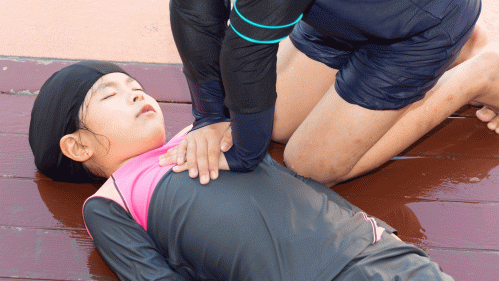Bystander CPR Is Crucial in Rare Instances of Sudden Cardiac Arrest in Children

Rutgers emergency medicine experts highlight the importance of this lifesaving procedure for children’s activities
A 10-year-old boy on the baseball diamond goes into cardiac arrest while rounding the bases. A middle schooler falls unresponsive to the floor while sitting in class. A high school football player collapses after being struck in the chest.
About 2,000 young, seemingly healthy people under the age of 25 die annually of sudden cardiac arrest.
“Some of these children and young adults might have experienced previous symptoms, like shortness of breath or chest pain, but many do not have any symptoms of a heart problem until sudden cardiac arrest,” said Virteeka Sinha, an assistant professor of emergency medicine at Rutgers New Jersey Medical School. “Many of these deaths can be prevented by immediately performing cardiopulmonary resuscitation [CPR] and using an automated external defibrillator. However, so often this is not done.”
Sinha and Timothy Satty, an assistant professor at Rutgers New Jersey Medical School and medical director of emergency medical services at University Hospital, discuss how bystanders who know CPR can save children’s lives.
Should parents be concerned about sudden cardiac arrest?
Satty: It is important to note that while sudden cardiac arrest is rare in children, it can happen. It is a leading cause of death in young athletes and can occur when children are at rest as well as active. Importantly, bystander CPR, when administered immediately, can double or triple the survival rates. It is crucial for parents, coaches, educators and other children to be trained to administer CPR. Currently, 39 states, including New Jersey, mandate that public high school students receive instruction in CPR, or chest compressions to circulate the blood, and how to use a defibrillator, which is used to restore a normal heartbeat. New Jersey requires athletic coaches at public and private school to be certified in CPR and defibrillator use.
Can anyone do CPR?
Sinha: People think that CPR training takes a lot of time, but there are many courses that people can fit into their work schedules. The American Heart Association and American Red Cross have courses that can be completed in a few hours and even online. There is a particular need for more training in communities of color. Studies have shown that Black and Hispanic people who had sudden cardiac arrest were less likely to receive potentially lifesaving bystander CPR than those who were White, both in public and at home.
However, 911 dispatchers are trained to walk callers through the correct CPR procedure while waiting for emergency medical services to arrive.
How do I know a person needs CPR?
Sinha: CPR training will help you recognize a medical emergency. In general, however, you should call 911 and initiate CPR if there is no pulse or breathing within 10 seconds or when a person doesn’t recover from a sudden loss of consciousness in about 20 seconds or is deeply unresponsive to verbal cues like calling their name or gentle physical stimulation. When most people faint, they continue to breathe and will come around again relatively quickly. The circumstances in which the collapse occurs is also a clue. For example, a direct hit to the front of the chest, like from a hit baseball, especially can cause cardiac arrest.
When you call 911, the dispatcher will ask if the person is unconscious and breathing normally. People who have cardiac arrest sometime will occasionally have “agonal” breathing, which is not true breathing, but rather a reflex that happens when the brain is not getting enough oxygen. People will start taking gasping, slow breaths at strange intervals, which can fool bystanders into thinking they are breathing. If someone is having agonal breathing, start CPR immediately.
When should an automated external defibrillator be used?
Sinha: When someone is in cardiac arrest it is crucial to use a defibrillator as soon as possible, which reads the heart rhythm and, when appropriate, delivers an electrical shock to correct the abnormality. Ideally, one person would call 911 while another person starts CPR to keep blood flowing to the heart and brain.
These devices are now placed in schools, ball fields, restaurants and other public spaces. If your child is regularly at a certain location, you should identify where the defibrillators are kept before an emergency occurs. They are designed for the layperson and give instructions to the user once the button is clicked.
Satty: Activating emergency medical services by calling 911 is crucial. Until trained medical personnel arrive, however, people should also know that all states have Good Samaritan laws that protect people who help others in a medical emergency before trained rescue personnel arrive from legal repercussions if any injuries occur.


